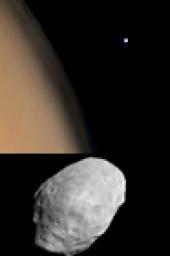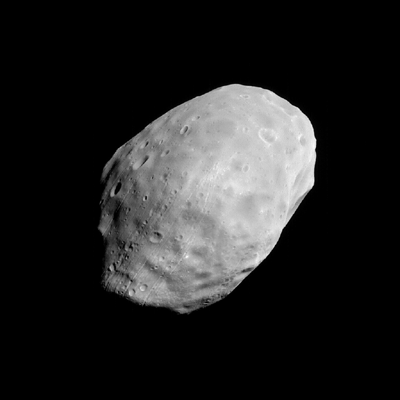
|
Phobos Over the Martian Limb
- Click the image above for a larger view
- Full-Res JPEG (93 x 140) (2.0 kB)
- Full-Res TIFF (93 x 140) (19.6 kB)
Caption:
MGS MOC Release No. MOC2-400, 23 June 2003
Mars has two natural satellites, or moons, Phobos and Deimos. On 1 June 2003, the Mars Global Surveyor (MGS) spacecraft was slewed eastward to capture these views of the inner moon, Phobos, shortly before it set over the afternoon limb. Phobos orbits Mars about 3 times a day at an average distance of 9,378 km (5,828 mi). About 0.006 times the size of Earth's Moon, Phobos is a potato-shaped object with dimensions approximately 27 by 22 by 18 kilometers (about 17 by 14 by 11 miles).
The first picture shown here is a color composite of four MGS Mars Orbiter Camera (MOC) wide angle images; the second is the same as the first, but indicates the location of Phobos. The third view is a MOC narrow angle image, taken at the same time as the wide angle views, showing details on the surface of the tiny moon.
Phobos is one of the darkest objects in the Solar System. Thus, four wide angle images were obtained to make the picture of Phobos over the martian limb: a pair of red and blue wide angle images was acquired for the limb, and a pair of separate images were required to see Phobos. The wide angle images illustrate the fact that Phobos is mostly colorless (dark gray); the faint orange/red hue in the wide angle picture is a combination of slight differences in the focal lengths of the blue and red cameras and the orange/red illumination provided by reflection of sunlight off Mars. To a person standing on Phobos, the red planet would fill most of the sky.
The high resolution image (bottom) was taken at the same time as the wide angle views. MGS was about 9,670 kilometers (6,010 miles) from Phobos when the picture was taken. At this distance, the image resolution is about 36 meters (470 ft.) per pixel; the maximum dimension of Phobos as seen in this image (the diagonal from lower left to upper right) is just over 24 km (15 mi). This is the "trailing" hemisphere, the part of Phobos that faces opposite the direction that the moon orbits Mars. This is a part of Phobos that was not seen by MOC in 1998, when MGS made several close flybys of the tiny moon.
The rows of grooves and aligned pits on Phobos are related to, and were probably caused by, a large meteor impact that occurred on the side of Phobos that is not seen here. That large crater, Stickney, was named for the maiden name of the wife of the astronomer that discovered Phobos and the other martian satellite, Deimos, in 1877, Asaph Hall.
Examples, with descriptive captions, of the views of Phobos obtained by MOC in 1998 can be seen at:
http://www.msss.com/mars_images/moc/9_11_98_phobos_rel/ http://www.msss.com/mars_images/moc/2003/05/16/
All of the previous MOC images of Phobos are available in the MOC Gallery at:
http://www.msss.com/moc_gallery/ab1_m04/natables/na999.html http://www.msss.com/moc_gallery/ab1_m04/watables/wa999.html
Cataloging Keywords:
| Name | Value | Additional Values |
|---|---|---|
| Target | Mars | Deimos, Phobos |
| System | Mars | |
| Target Type | Planet | Satellite |
| Mission | Mars Global Surveyor (MGS) | |
| Instrument Host | Mars Global Surveyor | |
| Host Type | Orbiter | |
| Instrument | Mars Orbiter Camera (MOC) | |
| Detector | ||
| Extra Keywords | Color, Crater, Impact, Moon | |
| Acquisition Date | ||
| Release Date | 2003-06-23 | |
| Date in Caption | 2003-06-01 | 2003-06-23 |
| Image Credit | NASA/JPL/Malin Space Science Systems | |
| Source | photojournal.jpl.nasa.gov/catalog/PIA04589 | |
| Identifier | PIA04589 | |


